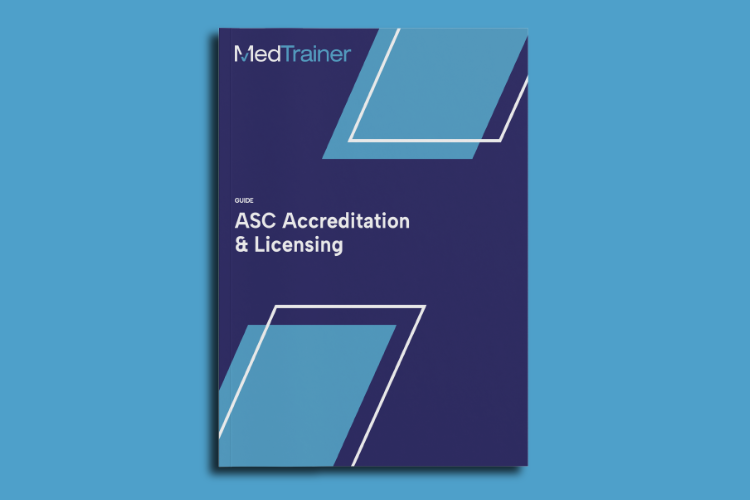Post authors Holly Nagatoshi, RN, BSN, MSN Ed. and David Shapiro, MD originally shared this information in an webinar. Watch now.
We have completed hundreds of healthcare accreditation surveys and the best all have one thing in common: they have given us confidence in the organization’s compliance.
We didn’t have to wait on the employees to find documents or watch them search through filing cabinets. We didn’t have to rush through things because time had been wasted earlier in the day. We have also noticed that many of the most prepared organizations are using an online compliance platform. From experience, this tells us that the organization prioritizes compliance and will typically have policies, documentation, and prepared staff ready for accreditation.
In this article, we will share our top six tips along with ways that technology can help.
What Is a Healthcare Accreditation Survey?
A healthcare accreditation survey is part of the process that organizations go through prior to becoming accredited or in order to be reaccredited. A survey is required by most accrediting organizations, including Accreditation Association for Ambulatory Health Care (AAAHC), The Joint Commission (TJC), and the Urgent Care Association (UCA). Each accrediting body has its own procedure and timeline; however, for the most part, surveyors aren’t looking to “catch” and penalize you. Rather, they’re looking for opportunities to help you improve!
You can expect surveyors will inspect the facility, interview staff, and review records. The specific duties of a surveyor will vary depending on the accrediting body, but often include:
- An unannounced visit (2 – 3 days, typically)
- Interviews with various staff members
- Facility tour, including a visit to the operating room (OR)
- Review of credentialing files and patient medical records
- Review documentation of inspections, fire drills, refrigerator temperature
- Logs, quality improvement studies, infection control policies, and a variety of other performance-related materials
- Inspection of medication security, medication expiration dates, and supplies
Get our best tips to navigate the accreditation process.
6 Accreditation Tips Straight From Surveyors
The best way to alleviate the stress of an accreditation survey is to be proactive. The more you can do to prepare for a surveyor’s visit and comply with their requests, the smoother the path to accreditation, certification or both.
Here’s the advice we shared in the webinar, Compliance Insights Straight From Surveyors, along with how technology can help.
1. Focus on organization.
Organization equals peace of mind for a surveyor. If you can’t find the documents you need in a timely manner or have disparate documents scattered across different locations, it tells the surveyor you’re disorganized — and potentially non-compliant. Accessibility to documents is also essential during an onsite survey. If you can’t find or access things easily, it becomes a risk management issue in the eyes of a surveyor.
How To Use Technology to Your Advantage
Set up your online system to match the standards of your accrediting body. By using standardized naming conventions that include the name of your accrediting body, it is easy to pull a report that includes all data for the survey. We also recommend setting up reports ahead of time so when a surveyor is onsite and needs something, it is simple to pull up the report to share.
2. Make sure all employees understand your policies.
Many healthcare organizations rely on standard policies — or buy policies and have them customized for their facility. All too often, employees don’t know what is in the policy, signaling that they have not thoroughly reviewed or received training on your policy. Even if they have, it’s still important to test competency and review skills and policies in huddles. Staff that can demonstrate knowledge of policies during interviews will instill a sense of confidence for the surveyor and show a commitment to compliance on the part of the organization.
How To Use Technology to Your Advantage
Record training on your policies and upload to a learning management system (LMS) so you can assign it to all new hires without having to redo the presentations. Plus, you can include (and track) post-training assessments so you know the competency level of employees.
3. Involve all employees in survey preparation.
The majority of time onsite during a survey is spent talking to people and very often we find employees who are unaware of policies or are not doing what their policies say they should be doing. We are not trying to surprise employees, so prepare them to answer questions or perform a task — such as testing emergency equipment. By observing them, I can be comfortable that everyone in the facility knows where the emergency equipment is and how to work it. We do want to watch a clinical case while we are there — if we can’t, we will have to do a re-survey.
How To Use Technology to Your Advantage
Set up your compliance software to match what the surveyor will be looking for. Make the technology part of your organization’s daily routine so everyone is comfortable accessing reports, safety data sheets, and policies when there’s a surveyor in front of them.
4. Don’t cram everything in right before a visit.
We are going to look very, very closely at what you do upon initial hire (within the first 30 to 60 days) to ensure the appropriate training has been completed. The dates on your training records should correspond to the hire day within the first year, and then on an annual basis thereafter so each employee is updated on what is new and what they’re learning year after year. We are also looking to make sure drills are done on a continuing basis. Again, it is a red flag if all drills are completed the week before we show up. In addition to completing the drills, we want to see documentation of scenario-based drills and that you’ve made changes following the drills.
How To Use Technology to Your Advantage
An all-in-one compliance platform can automate onboarding by role, including assigning all new hire training and policy acknowledgement. With automated reminders for staff and simple reporting, you can rest assured that training is completed on time. Admins can also receive reminders when training is set to expire, which is very helpful for staff who are not on the same schedule.
5. Enforce consistency at all sites.
It’s tough to maintain the same compliance standards at multiple sites — especially when you reach five or more locations. With consistent policies, requirements, and even naming conventions, it is much easier to ensure that all locations are receiving high-quality training and adhering to procedures. A quick, seven-minute huddle at the beginning of every shift is also a great way to reinforce skills and policies outside of training.
With multiple sites, it’s really difficult when you’re going through spreadsheets and papers to find the tracking. We also want to see meaningful training — you have to back it up with conversations and a way to document the conversations (recording a speaker or meeting that can be viewed later and answer post questions with). Join a quick 7-minute huddle at the beginning of the shift — including safety, scheduling, patient feedback, staff suggestions (document that people have attended and received the information) to share new practices or new safety features in a product.
How To Use Technology to Your Advantage
Requiring all employees to use the same technology, set up in the same way, makes it easy to standardize compliance across any number of locations. You know that all employees are completing high-quality training and providing the same details in online incident reports. This also makes identifying trends much simpler.
6. Keep credentialing information in one place.
Credentialing can be an arduous process if your approach is fragmented. Surveyors want to see that a) you’re on top of credentialing, and b) that your records are well-organized and easily accessible. Non-compliance in this area is a huge red flag — even if it’s just one person who isn’t up-to-date or whose licensure only recently lapsed. Keep credentialing information in one place and make sure it’s up to date, in real-time.
How To Use Technology to Your Advantage
Find a single-source credentialing system and stick to it. Make sure there’s efficient tracking of certification, background checks, delineation of privileges, etc., all centralized in one spot. Also, make sure there’s historical recordkeeping that allows you to prove your commitment to credentialing.
Making the Transition to Technology
Just because you have an online compliance platform does not mean that you are effectively using it. We’ve seen plenty of organizations move online without fully making a commitment or bringing their mess into the new system. Here are a couple tips we have based on what we’ve seen during healthcare accreditation surveys:
- Standardize everything as you transition, so you have clear records from the start.
- Replace old, outdated or inapplicable policies with new, revised, updated versions.
- Data integrity matters for an online system. Remember: garbage in; garbage out.
- Train everyone to use the system accordingly, and to document everything appropriately.
- Use every part of your system — it was purchased to help you stay compliant!
Think technology could help your facility get survey ready? Find out how MedTrainer can help.

